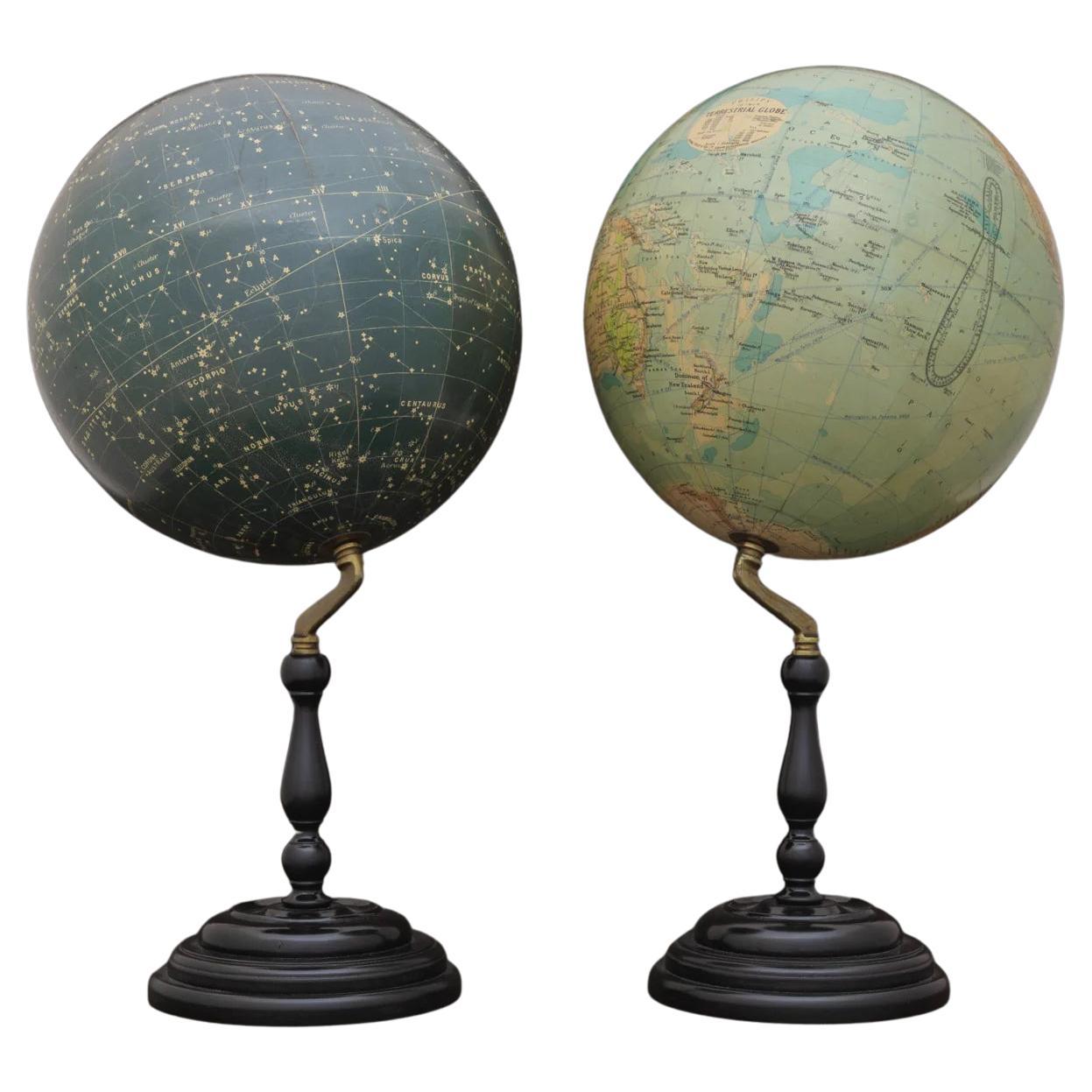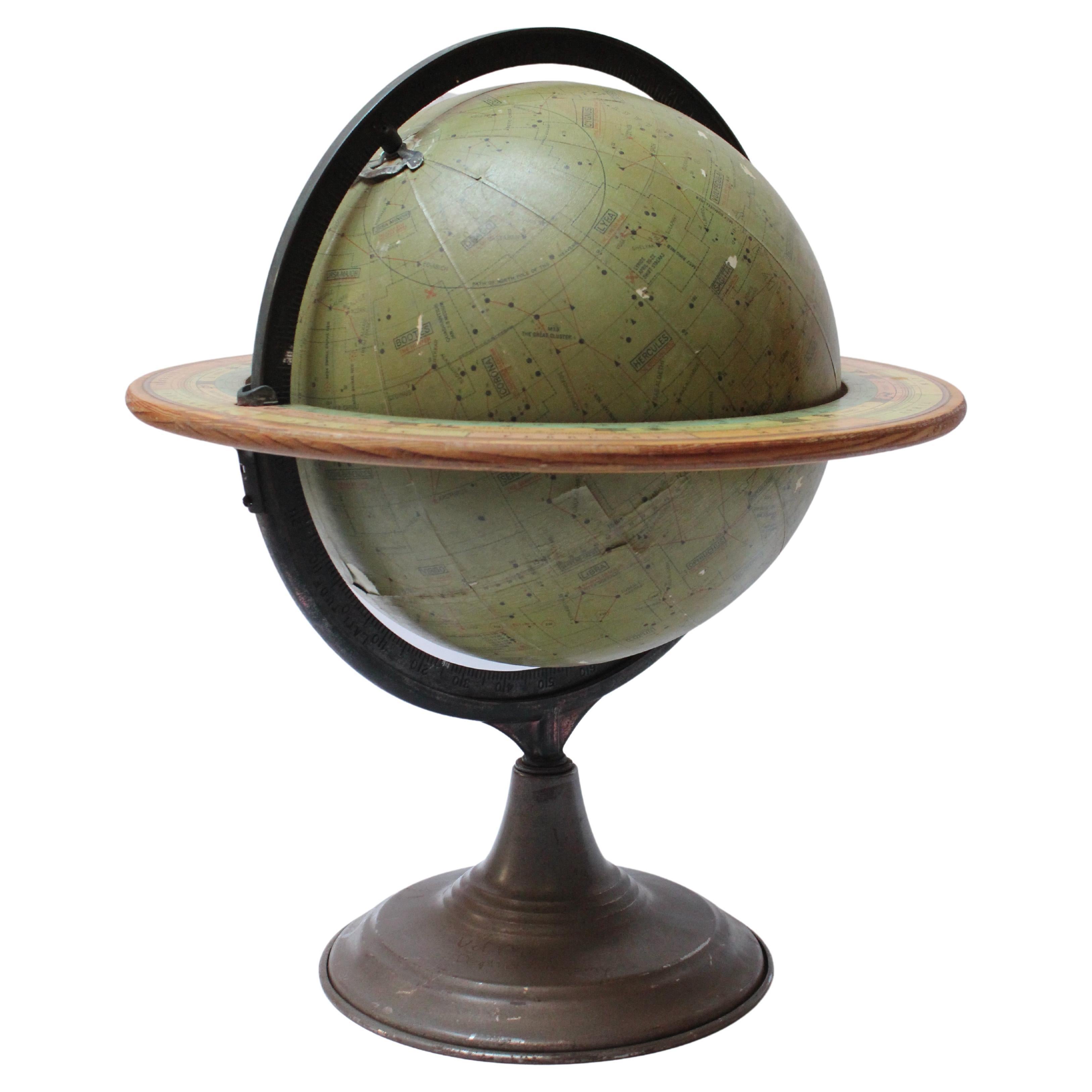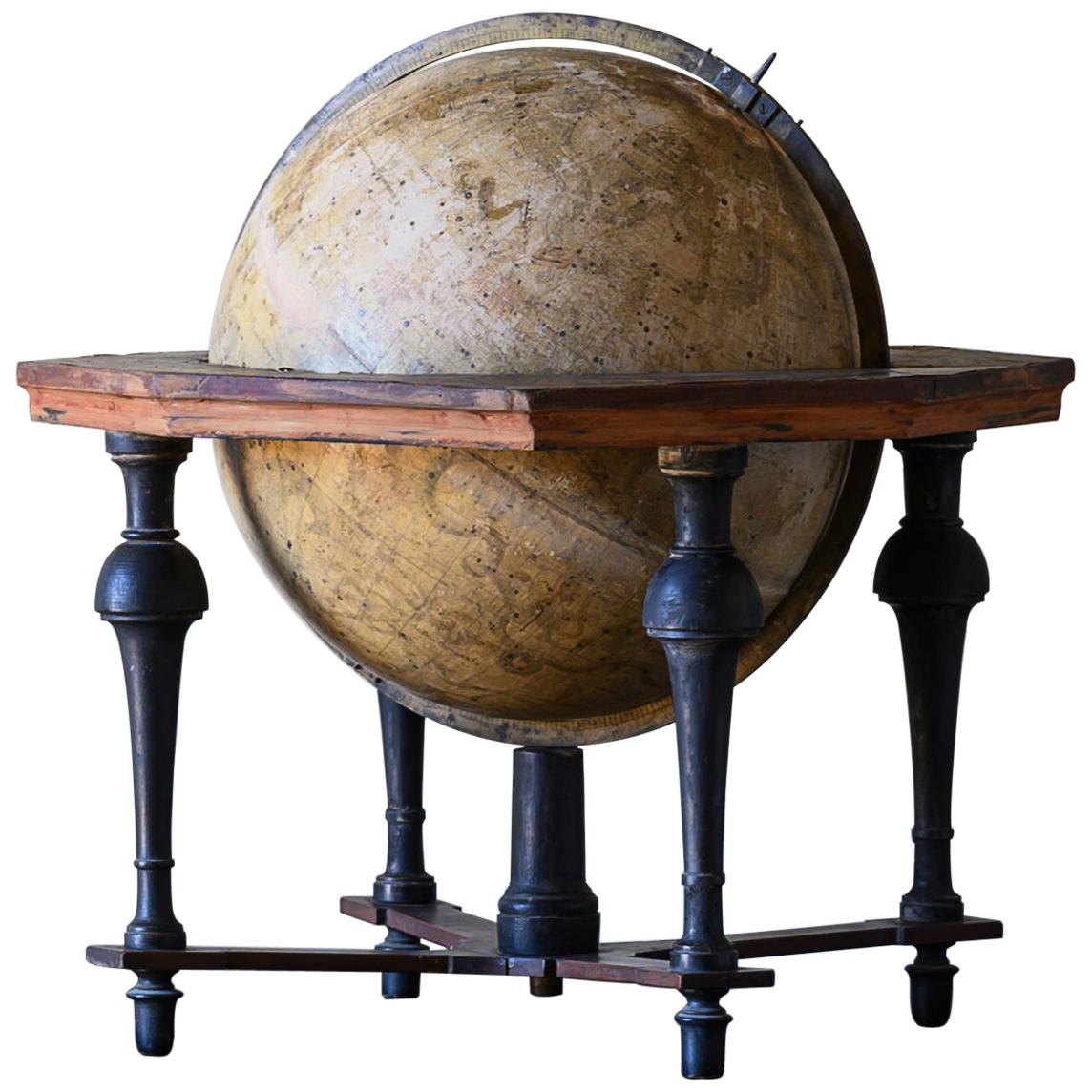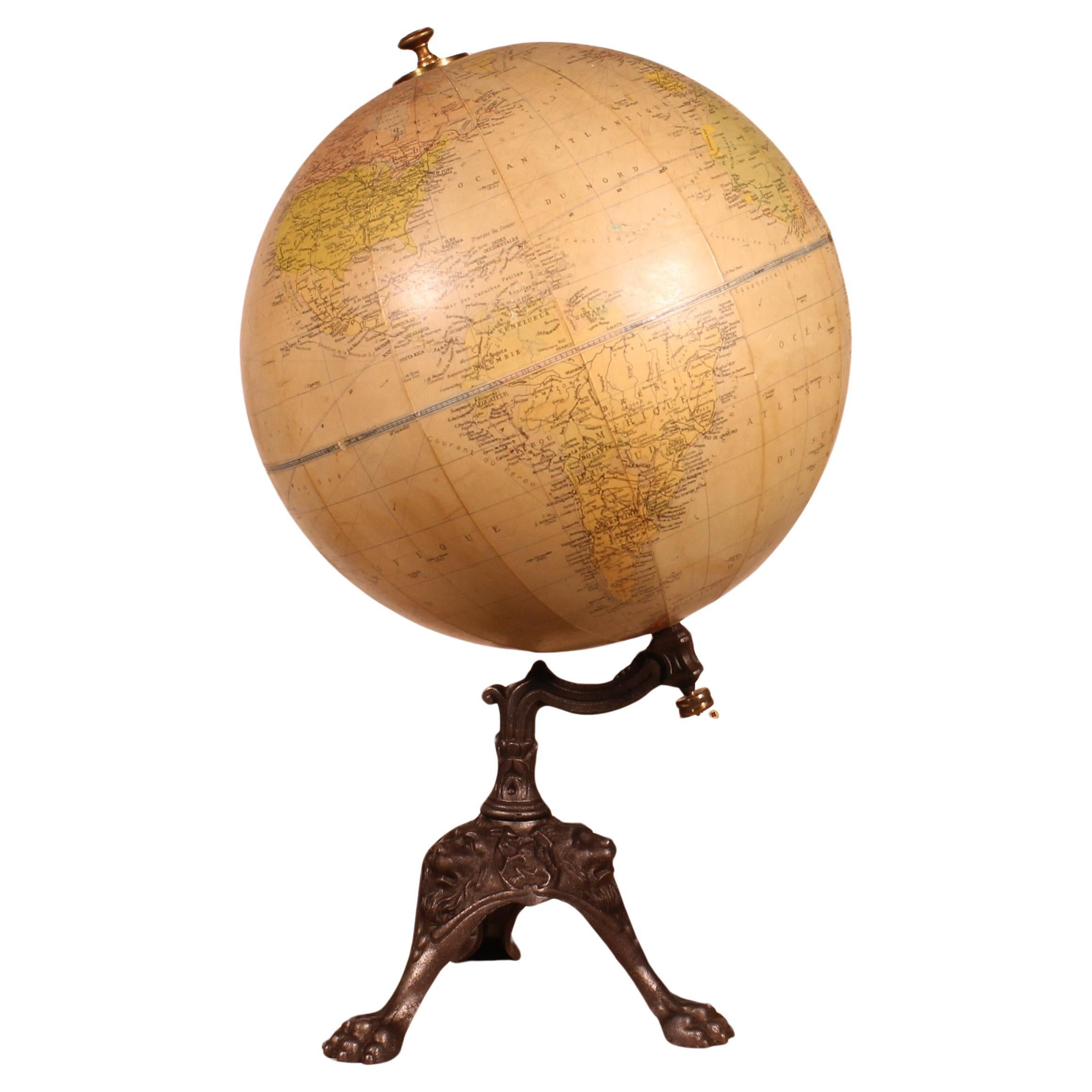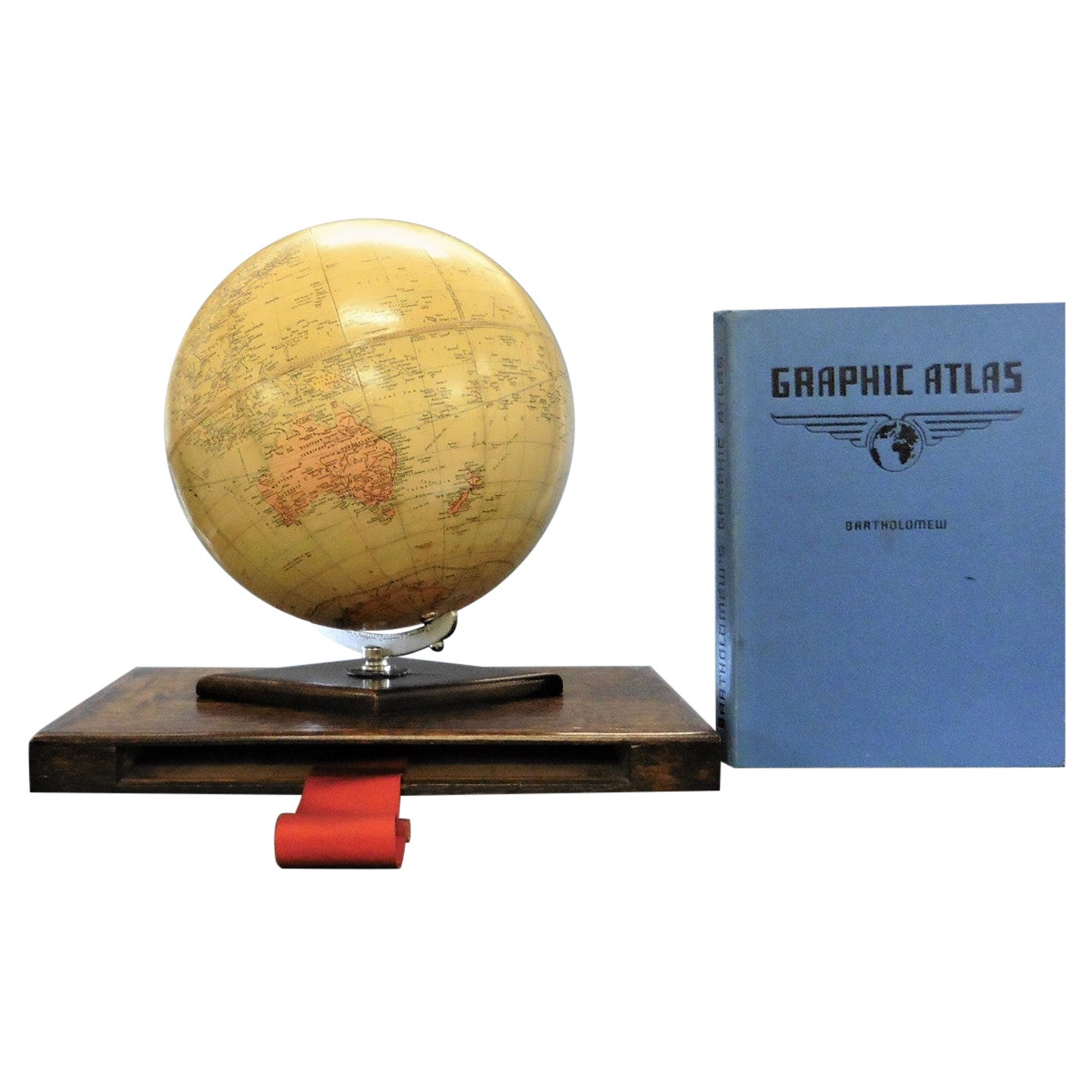Items Similar to Philips' Celestial Globe, circa 1935
Want more images or videos?
Request additional images or videos from the seller
1 of 10
Philips' Celestial Globe, circa 1935
About the Item
A stylish celestial globe on a brass inclined plain mount attached to original square bakelite base and secured at the top by a brass acorn finial. By George Philip and Son; circa 1935. A cartouche is present that includes the title and maker's address.
The globe is printed in beige against a dark background and shows the constellations and many named stars. Fine lines connect the stars within constellations rather than illustrating them as mythological and other figures.
When looking at the stars from Earth the viewpoint is effectively inside a celestial sphere. The surface of a celestial globe shows the star field as a projection viewed from the outside and is therefore reversed, with the constellations appearing as their mirror images.
Dimensions: 30.5 cm/12 inches (diameter) x 41.25 cm/16¼ inches (max. height).
George Philip, (1800–1882) was a cartographer and map publisher. He founded George Philip & Sons in 1834 in Liverpool primarily as a bookseller and stationer, but rapidly expanding to become a publisher of primarily maps, atlases and educational works. He had one son, also George (1823–1902), who was admitted to the business in 1848.
George senior was born in Huntly, Aberdeenshire and by 1819 he had become assistant to the Liverpool bookseller, William Grapel before going on to start his own business. He used cartographers (such as John Bartholomew the elder, August Petermann, and William Hughes) to produce maps on copper plates.
Philip then had these printed and hand-coloured by his women tinters. The business expanded rapidly and by the time he produced his county maps of 1862 he was using machine coloured maps produced on power-driven lithographic presses.
Philips’ production of globes in the 19th century was mainly limited to associations with other British globe makers, including Smith & Sons, London, but in 1902 Philip ventured into the production of globes as a manufacturer, facilitated by the firm’s establishment of the London Geographical Institute, a large factory for map, atlas, and globe production.
Globes from this era are generally constructed by forming a sphere made either of card or fibreboard covered by gesso (plaster) to ensure smoothness. The sphere was then overlaid with a map printed on long, thin elliptical strips of paper that narrow to a point at the North and South Poles.
Over the years, Philip acquired the production lines of other British globe makers including Malby, Betts, Smith and Johnston. The firm also supplied atlases and textbooks overseas starting with an atlas for Australian schools in 1865 and for New Zealand in 1869. The demand from board schools, established after 1870, enabled further expansion in the market for globes, atlases and wall maps.
Bentleys are Members of LAPADA, the London and Provincial Antique Dealers Association.
- Creator:George Philip & Son (Maker)
- Dimensions:Height: 16.25 in (41.28 cm)Diameter: 12 in (30.48 cm)
- Materials and Techniques:
- Place of Origin:
- Period:
- Date of Manufacture:circa 1935
- Condition:Wear consistent with age and use.
- Seller Location:London, GB
- Reference Number:1stDibs: LU960038541902
About the Seller
5.0
Vetted Seller
These experienced sellers undergo a comprehensive evaluation by our team of in-house experts.
Established in 1989
1stDibs seller since 2013
64 sales on 1stDibs
Associations
LAPADA - The Association of Arts & Antiques Dealers
- ShippingRetrieving quote...Ships From: London, United Kingdom
- Return PolicyThis item cannot be returned.
More From This SellerView All
- Pair of Philip & Son Globes, circa 1946By George Philip & SonLocated in London, GBA wonderful set of Terrestrial and Celestial 12 inch globes by George Philip and Son. Presented on brass inclined plain mounts attached to original turned ebonized wooden bases and uprights with axes secured at the top by brass acorn finials. Unusually, the terrestrial globe has a copyright date shown under the cartouche, 1946. The celestial globe is printed in beige against a dark blue background and shows the constellations and many named stars. Solid lines connect the stars within constellations rather than illustrating them as mythological and other figures.? A cartouche is present that includes the title and maker's address. When looking at the stars from Earth the viewpoint is effectively inside a celestial sphere. The surface of a celestial globe shows the star field as a projection viewed from the outside and is therefore reversed, with the constellations appearing as their mirror images. The terrestrial globe is printed in several colours and comprises of twelve coated lithographic paper gores with polar calottes over a twelve inch card sphere. The age of the globe has been confirmed by the political borders and named cities displayed. The globe is nicely detailed and has a grid network of parallels and meridians. It shows all the continents and countries as they were at the time it was printed and also indicates all the principal steamship routes with distances in nautical miles. The globe also has a printed Analemma - a diagram showing the declination of the Sun for every day in the year and the equation of time. The Analemma therefore shows the position of the Sun in the sky as seen from a fixed location on Earth at the same mean solar time, as the sun's position varies over the course of a year. A cartouche is present that includes the title and maker's address. Dimensions of each globe: 30.5 cm/12 inches (diameter) x 59 cm/23 1/4 inches (max height). George Philip, (1800–1882) was a cartographer and map publisher. He founded George Philip & Sons in 1834 in Liverpool primarily as a bookseller and stationer, but rapidly expanding to become a publisher of primarily maps, atlases and educational works. He had one son, also George (1823–1902), who was admitted to the business in 1848. George senior was born in Huntly, Aberdeenshire and by 1819 he had become assistant to the Liverpool bookseller, William Grapel before going on to start his own business. He used cartographers (such as John Bartholomew the elder, August Petermann, and William Hughes) to produce maps on copper plates. Philip then had these printed and hand-coloured by his women tinters. The business expanded rapidly and by the time he produced his county maps of 1862 he was using machine...Category
Vintage 1940s British Globes
MaterialsBrass
- Philips 14 Inch Globe, circa 1940By PhilipsLocated in London, GBA substantial 14 inch gesso terrestrial globe by Philips of London on brass inclined plain mount attached to original turned wooden based upright with axes secured at the top by a br...Category
Vintage 1940s British Globes
MaterialsGesso, Wood, Paper
- Louis Vuitton Leather Suitcase, circa 1935By Louis VuittonLocated in London, GBA lovely 'Vache Naturelle' case by Louis Vuitton. With original tray and leather lined interior that would have held a range of fittings; Circa 1935. This case also has three keys. ...Category
Vintage 1930s French Trunks and Luggage
MaterialsBrass
- Louis Vuitton Leather Case, circa 1935By Louis VuittonLocated in London, GBA beautiful Louis Vuitton leather overnight case, circa 1935 in exceptional original condition, ideal for an overnight or weekend away. With original le...Category
Antique 1830s French Trunks and Luggage
MaterialsBrass
- Louis Vuitton 'Vache Naturelle' Tan Leather Suitcase, circa 1935By Louis VuittonLocated in London, GBA superb 'Vache Naturelle' suitcase by Louis Vuitton. With original cotton lined interior (missing tray), circa 1935. Louis Vuitton was founded by its namesake in 1854, with the fir...Category
Vintage 1930s French Trunks and Luggage
MaterialsBrass
- Chalons Steamer Trunk, circa 1915Located in London, GBA wonderful trunk by the French Grand Magasin, Chalons, of Alexandria Egypt. With brass fittings, and original interior lining and key, circa 1915. Dimens...Category
Vintage 1910s French Trunks and Luggage
MaterialsBrass
You May Also Like
- Vintage Dennoyer-Geppert Celestial GlobeLocated in Brooklyn, NYDennoyer-Geppert Celestial Globe designed by Commander Stubbs RNR (Royal Navy) for classroom astronomy demonstration purposes (ca. 1930, Chicago, IL.). Composed of paper gores in olive green over a hollow metal core, featuring an adjustable cast-metal meridian with bronze finish and a wood horizon...Category
Vintage 1930s American Art Deco Globes
MaterialsMetal
- 18th Century Celestial GlobeLocated in Mjöhult, SERare 18th century celestial globe (Globus Coelestis) on a stand in mahogany and blackened wood by Anders Akerman, 1759. In 1758, the "Cosmographic Society" was formed in Uppsala, ...Category
Antique Mid-18th Century Swedish Rococo Globes
MaterialsBrass
- Terrestrial Globe By PhilipsLocated in Brussels, BrusselsVery beautiful Terrestrial Globe made by Philips Londre based on the maps of Taride Paris Boulevard Saint Germain The Terrestrial Globe has a very beautiful cast iron base decorated...Category
20th Century British Napoleon III Globes
MaterialsPaper
- Philips 10 Inch Challenge GlobeLocated in Norwich, GBPhilips 10 inch challenge globe Philips 10 inch globe standing on a raised oak chamfered base and resting on a rectangular oak base incorporating a ribbon p...Category
Vintage 1950s English Globes
MaterialsOak
- Celestial Globe, Sweden, Early 19th CenturyLocated in Kastrup, DKBlack wooden celestial globe in original condition. Blackened wood, horizon circle and brass rings with longitude measurements. Mounted on wooden stand with turned legs and bun fee...Category
Antique Early 19th Century Globes
MaterialsWood
- Celestial Table Globe by Harris and SonLocated in Lymington, HampshireA 12 inch celestial table globe by Harris and Son, the horizon ring, with the original papers, set on four turned mahogany legs, the label statin...Category
Antique 1810s English Globes
MaterialsMahogany
